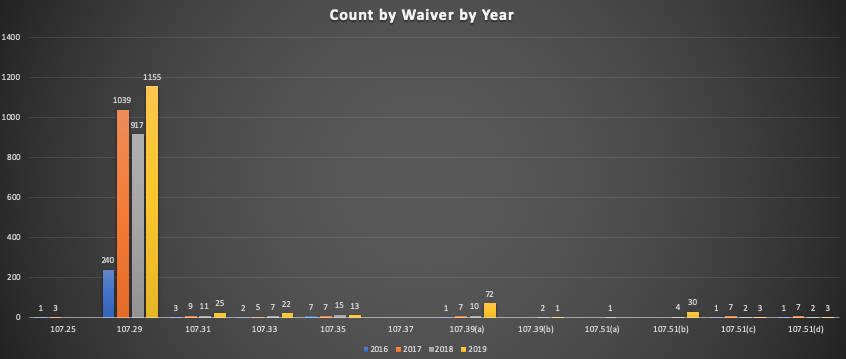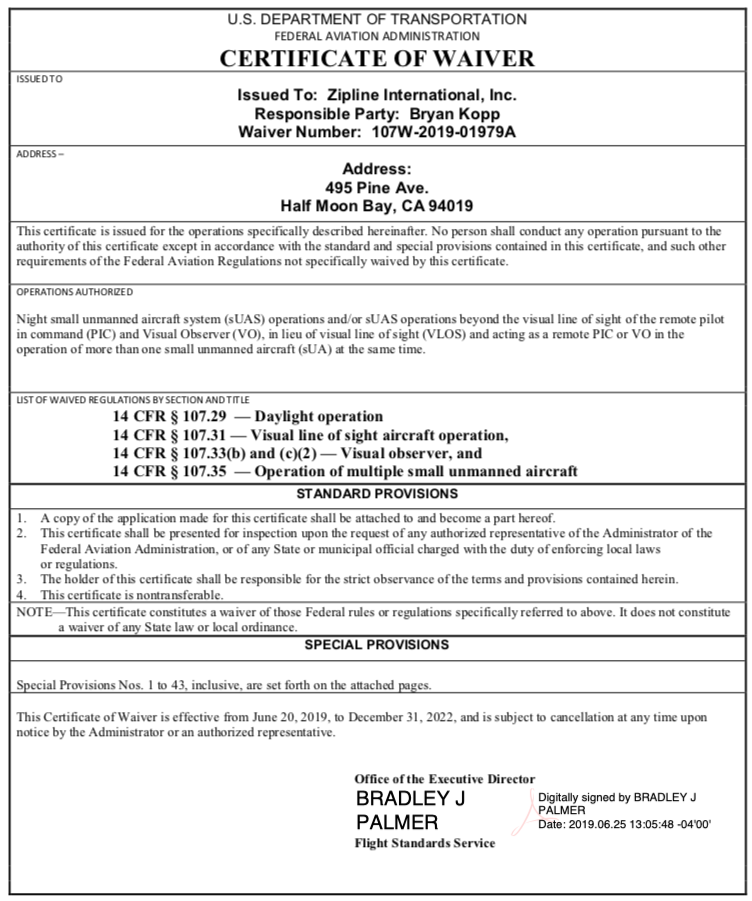Special Episode: 2019 Waiver Review
Welcome to a special edition of Waiver Watch!
We’re excited about this one, it’s our first look back at a full year’s worth of waivers. What was approved, how much of each, who was obtaining the hottest waivers, and more. Lots to cover so let’s dive in!
First, a comparison of total waivers granted year over year.
2016 is the oddball year because Part 107 regulations were only released on August 29, 2016.
From 2017 to 2019, regulations have been approved at a fairly consistent rate of an average 1093 per year. 2019 was the FAA’s best year yet though with 1275 waivers approved. This is an 34.5% increase over 2018. Nice!
Second, a comparison of individual regulations waived year over year.
107.29 - Daylight Operations waivers are king! Did you know that since 2016, 95% of all waivers granted have been for 107.29? This is pretty evident by the graph below showing waivers approved per year, grouped by regulation.
107.29 - Daylight Operations skew the scale so drastically in the first graph that we made a second graph without 107.29 to give a better picture what else is happening with waivers.
As we said earlier though, 2019 was a great year for waivers in many ways. They were higher totals of waivers approved across most regulations. Some of the highlights include:
26% increase in 107.29 - Daylight Operations waivers granted compared to 2018
227% increase in 107.31/107.33 waiver granted (typically called BVLOS waivers) compared to 2018
15% decrease in 107.35 waivers granted (this is one of the few decreases) compared to 2018
720% increase in 107.39(a) waivers granted compared to 2018
750% increase in 107.51(b) waivers granted compared to 2018
107.31, 107.33, 107.39(a), and 107.51(b) were the stars of the year
The following is a simple pie chart of waivers granted in 2019 by regulation:
The hardest waiver to get is arguably BVLOS, or a waiver to 107.31 & 107.33. Let’s take a look at the companies approved for 107.31/107.33 waivers (in other words BVLOS of some sort) in 2019:
PrecisionHawk USA, Inc
Massachusetts Dept of Transportation - Aeronautics Division UAS
Honeywell Aerospace
University of Alaska Fairbanks x2
UPS Flight Forward Inc
Flirtey America, Inc
Xcel Energy
Airbus Aerial
NTSB
Flirtey, Inc
State Farm Mutual Automobile Insurance and Affiliated Entities x2
Northern Plains UAS Test Site x2 (yours truly as Responsible Person)
CSU Drone Center
Nextera Energy
Zipline International, Inc.
Wing x2
Anduril Industries
Pinnacl X
Choctaw Nation of Oklahoma
Dominion Energy
Lucas Fischer (Uber?)
BVLOS Waivers by Industry Group
These companies are really the Who’s Who in the UAS industry! Many of these companies are engaged in FAA programs such as the UAS Test Sites, Partnership for Safety Program (PSP), and Integration Pilot Program (IPP). These programs really got going in 2019 and made some incredible advancements and progress on challenging UAS industry barriers such as Detect and Avoid and Command and Control. Looking forward to their successes and more in 2020!
Let’s take a look at a few more lists of companies receiving other advanced waivers.
Companies that received waivers to 107.35:
Northrop Grumman
Flirtey America, Inc (Flirtey, Inc.)
Hireuavpro.com
Zipline International, Inc
Firefly Drone Shows
TORC Robotics
Jane Huang
Anduril Industries
Wing Aviation LLC
AIRXOS
Companies that received waivers to 107.39:
107.39(a) approvals exponentially grew in 2019 due to the ASTM F3322-18 parachute standard being approved. ParaZero led, and still leads, the charge to enabling Operations Over Human Beings. We’d love to highlight all the companies receiving those initial waivers but frankly it grew to over 70 by the end of 2019!
Companies that lead this effort however were North Dakota Department of Transportation, ND Highway Patrol, and Burleigh County Sheriff’s Department. These three agencies were among the first to receive 107.39(a) waivers using the ParaZero SafeAir system and Northern Plains UAS Test Site supported the ASTM testing of the parachute and initial waiver requests.
Companies that received waivers to 107.51(b):
Colorado State University (CSU) Drone Center
Stuart McAllister
Zihan Zhu
The MITRE Corp x2
Monte McCoy
Cang Truong x2
Dustin LaGrone
Caleb Kingbeil
Jason Schreiber
Freeport McMoRan
Keene State College x2
Anduril Industries
Lehigh Valley Drone
The Penn State
UNL Biological Systems Engineering
LS Telcom, Inc
SC Recon LLC
Intel Corporation x2
Airobotics
Mavic Lacey
MORSE Corp
C.D. Smith Construction Inc
Black Swift Technologies LLC x2
Pete Karl
Menominee Tribal Enterprises
Finally, Jakee and Brent’s favorite waivers of 2019!
We can’t wrap up this episode without telling you all our favorite two waivers of the year, one for Jakee and one for Brent. Here they are!
Jakee’s Favorite
107W-2019-01979 | Zipline International, Inc
Zipline International, Inc received a waiver to 107.29, 107.31, 107.33(b) & (c)(2), and 107.35 in 2019 and this waiver is awesome for a number of reasons:
Any waiver to 107.35 is a win in my book, one person being able to operate multiple UAS simultaneously truly starts to unlock the potential of UAS. One of the key strengths of UAS is nobody is inside, they are highly autonomous, and once they reach a level of maturity and reliability, the pilot just becomes a monitoring tool. So instead of monitoring one UAS fly along, why not monitor many UAS flying along?
The waiver adds BVLOS capabilities, although in this case it is assumed to be daisy-chain visual observers since the provisions require the use of at least one Visual Observer.
Finally, Zipline International is just an amazing company and has really stood the test of time so far in the UAS industry. The company is laser focused on medical delivery and has been providing tremendous societal benefits in Rwanda for some time now.
This waiver is only their second in the US, the first being a waiver only to 107.35 back in May of 2018. So this waiver indicates they’re really beginning to test and scale their operations in the US as they engage in the Integration Pilot Program. We wish them success in 2020!
Brent’s Favorite
107W-2019-04978 | NOAA UAS
NOAA UAS received a waiver to 107.51(c) & 107.51(d) in 2019 to operate UAS below 107 weather minimums off the coast of Southern California. Wing is the only other company to receive this combination waiver in 2019. This waiver is awesome because:
The Responsible Person, Commander Jonathan Neuhaus of NOAA, is a manned and unmanned pilot. He flies a variety of awesome aircraft such as King Air’s, Twin Otters, Citation II, Global Hawks, and now small UAS it seems. Small UAS must be boring compared to the other aircraft he flies!
The waiver allows CDR Neuhaus to operate in as little as 1 SM of visibility with no limitations on cloud clearances. Must be some foggy areas he’s operating in!
Wrap Up
Thanks for joining us on this special episode of Waiver Watch where we reviewed waivers approved in 2019! We’ll be back to our regular format next week so see back here then.









